 Warning
Warning
Due to the current health emergency situation visiting times and arrangements may be subject to change. It is therefore advisable to check these by contacting the garden directly.
A castle-palace of medieval origin surrounded by a splendid Romantic landscape park laid out in 1833 replacing a pre-existent 18th-century formal garden, with centuries-old plants, statues, a pond, greenhouses and a “Café Haus”.
In the early 18th-century, the Meli Lupi family entrusted Giovanni Battista Bettoli with the creation of a great Italian garden with statues for their old medieval castle-palace that during the 16th and 17th century had been converted into a lavish residence. The garden was further extended in 1781 by Prince Guido. In 1833 his descendant Casimiro commissioned architect Luigi Voghera to transform the outdoor space into a landscape park, with meandering pathways winding their way between hills and tall-tree groves creating pleasantly interesting views. The layout includes a wide selection of species, including American black walnut, one of the largest in Europe, Japanese beech, ginkgo biloba, magnolia, chestnut, black locust, hazel and acacia, plus a considerable variety of flowers. At the centre of a small lake designed by Voghera is the “Isola dell’Amore”, an “island of love” with grottos decorated scenographic stalactites and stalagmites. A double ramp staircase with 18th-century statues representing the Nile, the Ganges and the Four Seasons connects the garden to the Rocca Meli Lupi building. At the far end of the park there are the Neoclassic Café Haus and a greenhouse with a luxuriant rose garden nearby. Also notable is the park’s selection of 18th-century Venetian statues.
Highlights
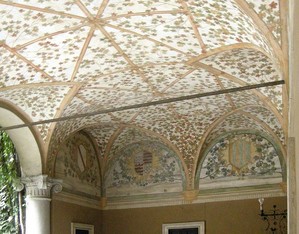
The Corte d’Onore
A vaulted porch with mid-15th-century frescoes overlooks the court of honour. With a grapevine pattern on the ceiling, the parietal lunettes feature the emblems of the families that over the centuries became related to the Meli Lupi lineage.
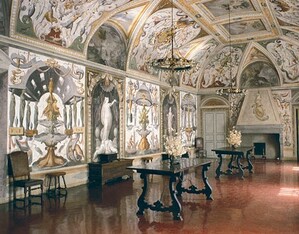
Sala delle Grottesche
This hall is also known as “del Baglione” since it was frescoed by Cesare Baglione from Cremona, an artist who lived between the 16th and the 17th century who fully expressed his creative flair in the so-called “grottesche”, the particular ornamental style inspired by the Roman decorative art unearthed in Pompeii. At the centre of the vault, the emblem of the Farnese and of the Dukes of Parma and Piacenza; the lunettes are frescoed with fine landscape scenes.
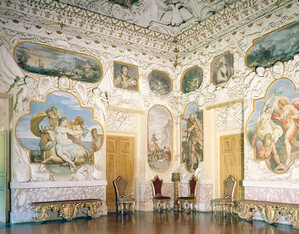
Sala degli Stucchi
The stucco and fresco decorative apparatus of this room by Ferdinando and Francesco Galli Bibiena depicts mythological scenes and episodes related to the history of the Meli Lupi family and their feats against the Ottomans.
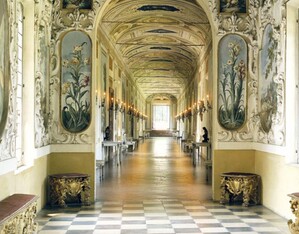
Galleria dei Poeti
This gallery of poets comprises three sections: the first featuring a parietal décor by the Bibiena brothers, the second, literary and mythological subjects by Giovanni Motta, while the third is dedicated to Apollo. Also present in this space is a set of twelve herms of the most illustrious poets of all times: Dante, Petrarch, Ariosto, Tasso and other Greek and Latin authors.
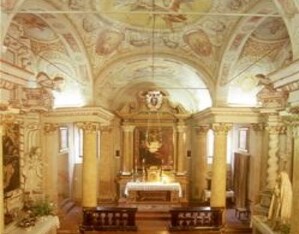
Oratory of Santa Croce
Erected by Vigilante Petardi in the early 17th century to serve as a family mortuary chapel, this Baroque architecture features a vault decorated with frescoes by Giacomo Mercoli, marbles sculpted by Pietro Oliva and an altarpiece with a Crucifixion by Giovanni Bolla.
 Rocca Meli Lupi
Contacts
Rocca Meli Lupi
Contacts
Contacts
Telephone:+39 0524 597978
Address
Piazza Bonifacio Meli Lupi, 5
43019, Soragna (PR)
 Rocca Meli Lupi
Opening times and prices
Rocca Meli Lupi
Opening times and prices
Opening hours
Garden hours
- saturday 4:00 pm
- Sunday 10:30 am and 4:00 pm
Reservations are required. In case of bad weather the visit is suspended.
The Fortress of Soragna can be visited, by kind permission of the Prince and in the areas not reserved for private use, at the following times:
- every Tuesday, Wednesday, Thursday and Friday from 3.00 pm to 5.30* pm.
- every Saturday and Sunday from 10.00 am to 11.00 am* and from 3.00 pm to 5.30 pm*.
- (* start of last guided tour)
Reservation is required to enter the rooms of the fortress and the use of a mask will be required.
It is advisable to consult the website or contact the Rocca by phone to find out the times and/or limitations to the visit.
The Fortress is closed:
- non-holiday Monday (consult also the extraordinary closures on the website)
Pricing
Visiting the Park
- Full price: € 4,00
- Reduced price: € 2,00
Guided tours to the rooms of the Meli Lupi Fortress
- Single: € 9,00
- Group: € 8,00
- Students (up to 18 years): € 5,00
- Children: € 4,00.
- Entrance to castles card: € 8,00
 Rocca Meli Lupi
How to get there
Rocca Meli Lupi
How to get there
Address
Piazza Bonifacio Meli Lupi, 5
43019, Soragna (PR)
Latitude: 44.9272123
Longitude: 10.1222978
How to arrive by road
From the A1 motorway, take the Fidenza-Salsomaggiore exit.
How to arrive by train
Get off at Fidenza station, the Rocca is about 10 km from the centre.
 Rocca Meli Lupi
Services/Accessibility
Rocca Meli Lupi
Services/Accessibility
Services
Guided tours:
- Guided tours are organised at the Rocca, with in-house guides also in English and French.
 Rocca Meli Lupi
Private events
Rocca Meli Lupi
Private events
At the Rocca di Soragna it is possible to organize many private events such as weddings, conferences, gala dinners, musical concerts, theatrical performances, photo shoots and film sets.
 Rocca Meli Lupi
Itineraries
Rocca Meli Lupi
Itineraries
You could find the garden in these itineraries
 Favorite saving result
Favorite saving result
 Warning!
Warning!
You've have to sign up or sign in to add this element to your favorites.
